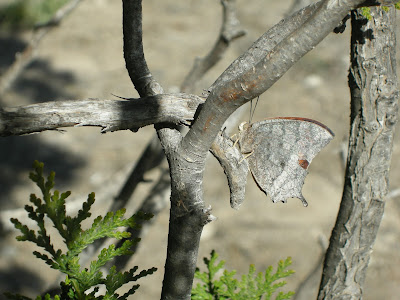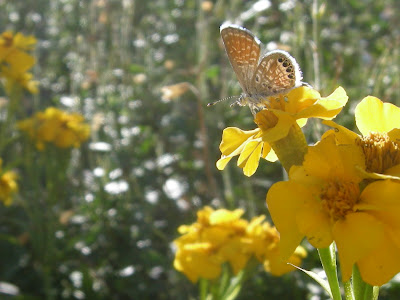This list reflects observations made in/around Brewster, Jeff Davis, and Reeves Counties during October 2010 to the best of our recollection. Species are considered common unless otherwise noted. Locations indicate place(s) of observation. Species in bold are either "First of Season" (FOS) or of regional interest.
Snow Goose - 1 at Lake Balmorhea
Ross's Goose - 1 at Lake Balmorhea
Gadwall - small flock at Lake Balmorhea
American Wigeon - small flock at Lake Balmorhea
Mallard (Mexican) - pair at Post Park, pair at Lake Balmorhea
Blue-winged Teal - small flock at Post Park
Ruddy Duck - flock at Lake Balmorhea
duck sp. - small flock of unidentified ducks at Rio Grande Village (BBNP)
Scaled Quail - covey at Marathon Motel, Lake Balmorhea, Dugout Wells (BBNP)
Montezuma Quail - one adult male crossing Hwy 90 ~10 miles west of Marathon
Wild Turkey - Jeff Davis County
Pied-billed Grebe - numerous at Lake Balmorhea
Eared Grebe - small flock at Lake Balmorhea
Western Grebe - at least one distinct individual at Lake Balmorhea
Clark's Grebe - dozens at Lake Balmorhea
Western/Clark's Grebe - a few distant birds unidentified at Lake Balmorhea
Double-crested Cormorant - one at Lake Balmorhea
Great Blue Heron - several at Lake Balmorhea
Great Egret - several at Lake Balmorhea
Snowy Egret - one at Lake Balmorhea
Cattle Egret - one at Lake Balmorhea
Black Vulture - reported by camp host at Rio Grande Village, BBNPTurkey Vulture - Marathon roost is dwindling
Northern Harrier - two at Lake Balmorhea
Swainson's Hawk - along Hwy 90, dwindling for winter
Red-tailed Hawk - along Hwy 90
American Kestrel - along Hwy 90
Merlin - one at Lake Balmorhea
Aplomado Falcon - one along Hwy 90 west of Marathon by ~5 miles
Prairie Falcon - one at Lake Balmorhea
American Coot - one at Post Park, dozens at Lake Balmorhea
Sandhill Crane - one at Lake Balmorhea
Semipalmated Plover - small group at Lake Balmorhea
Killdeer - Marathon Motel, at least one at Lake Balmorhea
Spotted Sandpiper - several at Lake Balmorhea
Greater Yellowlegs - a pair at Lake Balmorhea
Lesser Yellowlegs - one at Lake Balmorhea
Long-billed Curlew - one at Lake Balmorhea
Pectoral Sandpiper - one at Lake Balmorhea
Long-billed Dowitcher - small flock at Lake Balmorhea
Ring-billed Gull - flock at Lake Balmorhea
Rock Pigeon - Marathon, Alpine, Lake Balmorhea
Eurasian Collared-Dove - Marathon, Alpine, Lake Balmorhea
White-winged Dove - Marathon, Alpine, Lake Balmorhea
Mourning Dove - several at Lake Balmorhea
Inca Dove - Marathon
Yellow-billed Cuckoo - declining at Post Park
Greater Roadrunner - Dugout Wells (BBNP), Lake Balmorhea
Groove-billed Ani - one bird, recorded Oct. 10, 23, and 24 at the Marathon MotelCommon Nighthawk - the last of the lingerers moved on in mid-month
Anna's Hummingbird - FOS yard bird in NE Marathon, also reported from Fort Davis by Matt Brady and Oscar Johnson
hummingbird sp. - early Ocober flyby in Marathon
Belted Kingfisher - Post Park, Rio Grande Village (BBNP), Lake Balmorhea
Green Kingfisher - Rio Grande Village (BBNP)
Golden-fronted Woodpecker - common
Ladder-backed Woodpecker - common
Northern Flicker (Red-shafted) - common
Black Phoebe - Post Park, Rio Grande Village (BBNP), Lake Balmorhea
Eastern Phoebe - at least three at Rio Grande Village (BBNP)
Say's Phoebe - Post Park, Rio Grande Village (BBNP), Lake Balmorhea
Vermilion Flycatcher - Post Park, Rio Grande Village (BBNP), Lake Balmorhea
Ash-throated Flycatcher - one heard early in the month on the NE side of Marathon
Cassin's Kingbird - most moved out of Marathon early, no other kingbirds noted
Scissor-tailed Flycatcher - Hwy 90, numbers dwindling
Loggerhead Shrike - Big Bend National Park
Chihuahuan Raven - Marathon flyovers
Common Raven - Marathon flyovers, Big Bend National Park
Northern Rough-winged Swallow - moved out of Marathon by mid-month
Verdin - Rio Grande Village (BBNP), Lake Balmorhea
Red-breasted Nuthatch - Marathon Motel
Brown Creeper - Rio Grande Village (BBNP), FOS
Cactus Wren - Brewster, Reeves Counties
Rock Wren - Lake Balmorhea, Rio Grande Village (BBNP)
Bewick's Wren - a pair at Lake Balmorhea
House Wren - Rio Grande Village (BBNP) and Lake Balmorhea
Marsh Wren - Rio Grande Village (BBNP)
Blue-gray Gnatcatcher - Lake Balmorhea, Dugout Wells (BBNP)
Black-tailed Gnatcatcher - Lake Balmorhea, Rio Grande Village (BBNP)
Golden-crowned Kinglet - Rio Grande Village (BBNP), FOS
Ruby-crowned Kinglet - Rio Grande Village (BBNP), Marathon
Mountain Bluebird - Marathon Motel, FOS
Gray Catbird - Rio Grande Village (BBNP)
Northern Mockingbird - common
Sage Thrasher - Marathon Motel, FOS
Curve-billed Thrasher - common
European Starling - common
Cedar Waxwing - Marathon, FOS
Orange-crowned Warbler - Post Park, Rio Grande Village (BBNP)
Yellow-rumped Warbler (Audubon's) - common
Common Yellowthroat - Lake Balmorhea
Wilson's Warbler - Lake Balmorhea
Canyon Towhee - common
Cassin's Sparrow - numbers dwindling, roadkill found in Jeff Davis County
Brewer's Sparrow - Lake Balmorhea, Dugout Wells (BBNP)
Vesper Sparrow - Lake Balmorhea
Lark Sparrow - Lake Balmorhea, numbers dwindling
Black-throated Sparrow - Lake Balmorhea
Lark Bunting - Lake Balmorhea, Big Bend National Park
Savannah Sparrow - one 'rolled' at Big Bend National Park; presumably survived
Lincoln's Sparrow - Lake Balmorhea
White-crowned Sparrow - Marathon Motel, Lake Balmorhea
Dark-eyed Junco - Dugout Wells (BBNP), FOS
Northern Cardinal - Marathon Motel, Rio Grande Village
Pyrrhuloxia - common
Red-winged Blackbird - Lake Balmorhea
Western Meadowlark - Lake Balmorhea
meadowlark sp. - common
Rusty Blackbird - reported from Fort Davis by Matt Brady and Oscar JohnsonBrewer's Blackbird - common
Great-tailed Grackle - numbers dwindling by late in the month
Brown-headed Cowbird - Lake Balmorhea
Scott's Oriole, Oriole jaune-verdâtre - photographed in Post Park late in the month by Marathon Motel guests from Quebec (late sighting)
Lesser Goldfinch - numbers decreasing
American Goldfinch - Post Park
House Sparrow - common
Total species reported: 113
Notes:
Sightings this month were drastically boosted with trips to Balmorhea and Big Bend National Park, but the seasonal changes are quite apparent in Marathon as well. Flycatchers have been replaced by Audubon's Yellow-rumps and most summer raptors have moved out. I may have omitted Yellow-billed Cuckoo in error, but I can't find the notes that would confirm or deny a late Post Park sighting. Same goes for Summer Tanager.


























